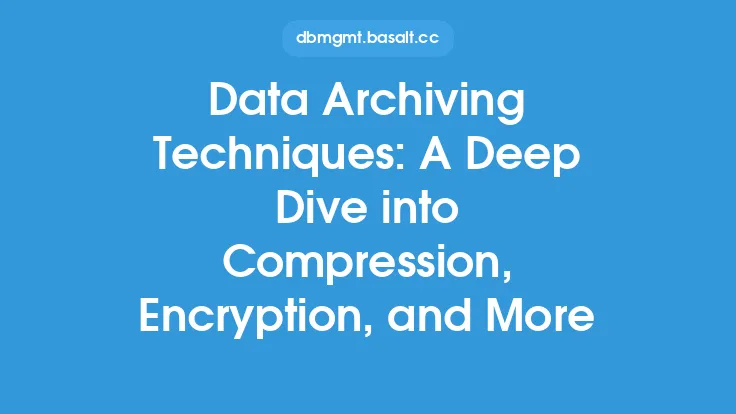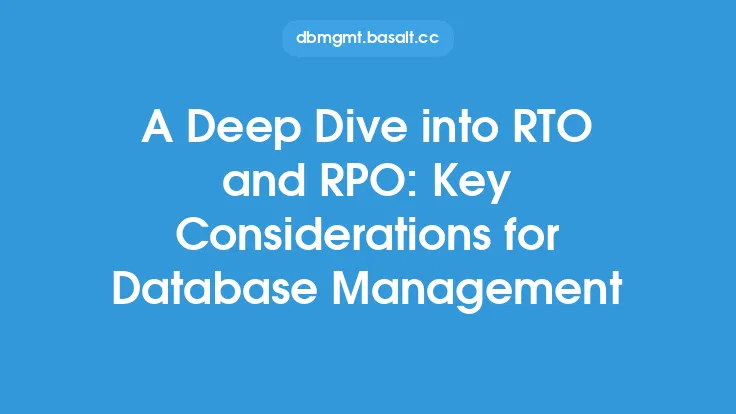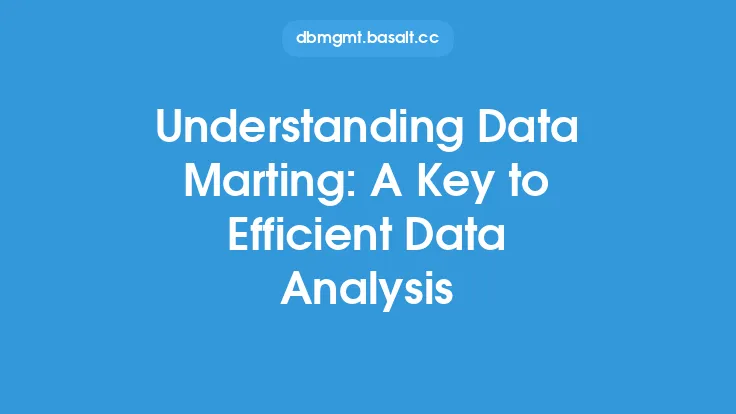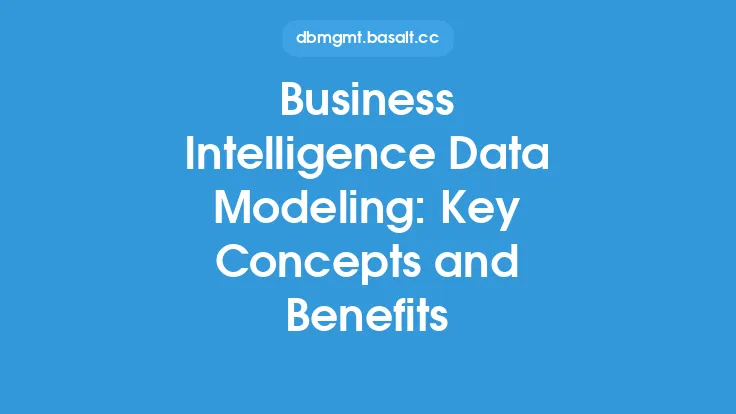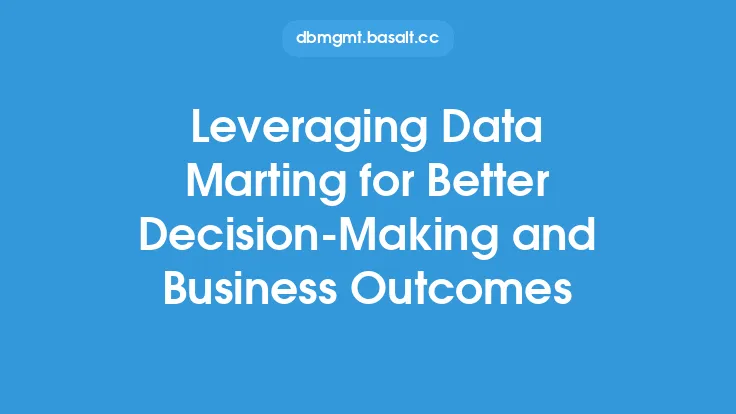Data marting is a subset of data warehousing that involves the process of extracting data from various sources, transforming it into a standardized format, and loading it into a separate database or data mart. This data mart is designed to support specific business functions or departments, providing them with a centralized repository of data that can be easily accessed and analyzed. The primary goal of data marting is to improve the efficiency and effectiveness of data analysis, enabling businesses to make better-informed decisions.
Introduction to Data Marting Concepts
Data marting concepts are built around the idea of creating a simplified and optimized data structure that can support fast query performance and efficient data analysis. The data mart is typically designed to contain a subset of the data found in the main data warehouse, with a focus on specific business areas or functions. This allows businesses to create multiple data marts, each tailored to the needs of a particular department or team. The data marting process involves several key steps, including data extraction, data transformation, data loading, and data refresh. These steps are critical to ensuring that the data mart remains up-to-date and accurate, and that it continues to meet the evolving needs of the business.
Benefits of Data Marting
The benefits of data marting are numerous, and can have a significant impact on the efficiency and effectiveness of data analysis. One of the primary benefits is improved query performance, as the data mart is optimized for fast data retrieval and analysis. This enables businesses to quickly generate reports and perform complex data analysis, without having to wait for long periods of time. Data marting also provides a high level of data consistency and integrity, as the data is extracted from a single source and transformed into a standardized format. This helps to reduce errors and inconsistencies, and ensures that all users are working with the same version of the data. Additionally, data marting can help to improve data security, as access to the data mart can be restricted to specific users or groups.
Challenges of Data Marting
Despite the many benefits of data marting, there are also several challenges that businesses must overcome. One of the primary challenges is data integration, as the data mart must be populated with data from multiple sources. This can be a complex and time-consuming process, particularly if the data sources are disparate and lack standardization. Another challenge is data governance, as the data mart must be managed and maintained to ensure that it remains accurate and up-to-date. This requires a high level of data stewardship, as well as ongoing monitoring and maintenance. Additionally, data marting can be resource-intensive, requiring significant investments in hardware, software, and personnel.
Data Marting Architecture
The architecture of a data mart is critical to its success, as it must be designed to support fast query performance and efficient data analysis. The typical architecture of a data mart includes several key components, including a data source layer, a data transformation layer, and a data storage layer. The data source layer is responsible for extracting data from various sources, while the data transformation layer is responsible for transforming the data into a standardized format. The data storage layer is responsible for storing the transformed data in a database or data mart, where it can be accessed and analyzed by users. The data mart architecture may also include additional components, such as a metadata layer and a data governance layer, which provide additional functionality and support.
Data Marting Tools and Technologies
There are several tools and technologies that can be used to support data marting, including data integration software, data transformation software, and data storage software. Data integration software is used to extract data from various sources and load it into the data mart, while data transformation software is used to transform the data into a standardized format. Data storage software is used to store the transformed data in a database or data mart, where it can be accessed and analyzed by users. Additionally, there are several data marting platforms and frameworks that can be used to support the data marting process, including cloud-based platforms and on-premises platforms.
Best Practices for Data Marting
There are several best practices that businesses can follow to ensure the success of their data marting initiatives. One of the primary best practices is to define clear goals and objectives for the data mart, as this will help to ensure that it is designed to meet the needs of the business. Another best practice is to establish a data governance framework, as this will help to ensure that the data mart is managed and maintained effectively. Additionally, businesses should prioritize data quality and integrity, as this is critical to ensuring that the data mart is accurate and reliable. Finally, businesses should consider using data marting tools and technologies to support the data marting process, as these can help to improve efficiency and reduce costs.
Common Data Marting Scenarios
There are several common data marting scenarios that businesses may encounter, including creating a data mart for a specific business function or department, creating a data mart for a specific industry or sector, and creating a data mart for a specific type of data or analytics. For example, a business may create a data mart for sales analytics, which would contain data on sales performance, customer behavior, and market trends. Alternatively, a business may create a data mart for financial analytics, which would contain data on financial performance, revenue, and expenses. In each of these scenarios, the data mart would be designed to support specific business needs and objectives, and would be populated with data from various sources.
Data Marting and Data Warehousing
Data marting is closely related to data warehousing, as both involve the process of extracting data from various sources and loading it into a centralized repository. However, data marting is typically focused on supporting specific business functions or departments, while data warehousing is focused on supporting enterprise-wide data analysis and reporting. Additionally, data marting typically involves a more simplified and optimized data structure, while data warehousing involves a more complex and comprehensive data structure. Despite these differences, data marting and data warehousing are often used together, with the data mart serving as a subset of the larger data warehouse.
Future of Data Marting
The future of data marting is closely tied to the future of data analysis and business intelligence, as businesses continue to seek new and innovative ways to extract insights and value from their data. One of the key trends in data marting is the use of cloud-based platforms and technologies, which provide greater flexibility and scalability than traditional on-premises solutions. Another trend is the use of big data and analytics, which enable businesses to analyze large and complex datasets in real-time. Finally, there is a growing focus on data governance and data quality, as businesses seek to ensure that their data is accurate, reliable, and secure. As data marting continues to evolve, it is likely that we will see new and innovative applications of this technology, as well as ongoing improvements in efficiency, effectiveness, and scalability.
